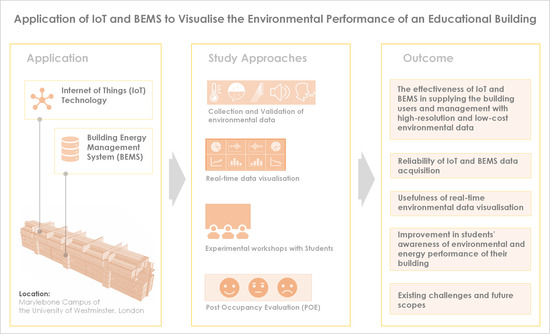Application of IoT and BEMS to Visualise the Environmental Performance of an Educational Building
Abstract
1. Introduction
2. Materials and Methods
2.1. Schedules and Areas of Investigation
2.2. Methods of Objective Data Collections and Validations
2.3. Educational Workshops and Post Occupancy Evaluation
3. Results and Discussions
3.1. Outcome of Spot Measurements
3.2. Results from IoT and BEMS Sensors
3.3. Results from BEMS and Tinytag Sensors
3.4. IoT Data Visualisation and Its Application
3.5. Application of IoT in Educational Workshops
3.6. Evidence from the Post Occupancy Evaluation Survey
3.7. Existing Challenges and Future Scope
4. Conclusions
- Spot measurement results showed the importance of locating the BEMS and IoT sensors above the work-plane level, i.e., 0.8 m–1 m high from the floor plate while considering the CO2 and Illuminance levels to obtain valid environmental data.
- Deviations between DBT values from IoT, BEMS, and Tinytag sensors also indicated that it is important to locate the BEMS sensors suspended and close to the work desk to represent the indoor environment that users experienced in both air-conditioned and naturally ventilated spaces assisted by BEMS.
- Considering the wide transmittance range of Wi-Fi network, the total number of IoT sensors can be reduced and thus IoT may be utilised as a cost-effective solution to validate the real-time environmental data. However, the energy consumption of IoT solutions should be further explored to establish this statement. Moreover, existing BEMS servers have to be updated to a higher Specification to expand its compatibility with IoT for synchronising these data effectively.
- BEMS sensors located on the 4th and 5th floors showed valid DBT values with minor deviations. However, other environmental sensors such as illuminance and sound level should be validated and integrated with the BEMS to improve the indoor environmental performance and energy efficiency.
- Both historic and real-time data-visualisation from IoT sensors may be useful not only to users for better understanding their working environment but also to building managers for regulating the BEMS system to improve environmental and energy performance.
- The educational workshop with students’ feedback demonstrated that IoT and real-time visualisation of environmental data were beneficial in improving their perception of the indoor thermal environment. These methods also enhanced students’ overall learning experience within the university.
- The POE results indicated that students have a more positive perception of the building performance, which could be linked to their improved understanding of their workspace environment as a positive effect of the educational workshops with IoT data visualisation.
Author Contributions
Funding
Acknowledgments
Conflicts of Interest
Appendix A
| Equipment Type | Name | Measurement Range | Specification |
|---|---|---|---|
| Hand-held Equipment for Spot Measurement | Testo 625—Thermo Hygrometer | DBT: −10 to + 60 °C; RH: 0.0 to 100.0% | Accuracy: ±0.5 °C (DBT); ±2.5% (5 to 95%RH) Resolution: 0.1 °C (DBT); 0.1% (RH) |
| Testo 535 CO2 meter | 0 to 9,999 ppm (0 to 0,999 vol.% CO2) | Accuracy: 0 to 5000 ppm: (at 23 °C) ± (75 ppm +3 % of m.v.) 5000 to 9999 ppm: ±(150 ppm + 5% of m.v.) Resolution: 1 ppm or 0.001 vol.% [36] | |
| The Hagner Digital Lux Meter EC1 | 0.1–200,000 lux | Accuracy: 0.1–200,000 lux | |
| BEMS (Trend) | Trend CO2, Temperature Space Sensors | DBT range: −20 °C to +40 °C; CO2 range: 0 to 2000 ppm | Accuracy: ±0.3 °C (DBT); ±50 ppm +2% of measured value (CO2); Specification web-link: [37] |
| Tinytag Data Loggers/Sensors | Tinytag Plus 2 | DBT: −25° C to +85 °C; RH: 0% to 100% | Accuracy: 0.01 °C or better (DBT); Better than 0.3% (RH) |
| IoT Sensors (Tinkerforge) and Accessories | Raspberry Pi zero Minicomputer | NA | Configuration: 1 GHz, Single-core CPU; 512 MB RAM; Mini HDMI and USB On-The-Go ports; Micro USB power; HAT-compatible 40-pin header; Composite video and reset headers; 802.11n wireless LAN; Bluetooth 4.0. |
| Humidity Bricklet 2.0 | DBT: 20 °C to 85 °C in 0.01 °C steps, 14 bit resolution RH: 0% to 100% in 0.01% steps. | Accuracy: ±0.2 °C (typical) for temperature (DBT); ±2% (typical) for humidity (RH) | |
| Colour Bricklet | 0–65,535 Lux | Illuminance Resolution: 16 bit | |
| Sound Pressure Level Bricklet | Sound Pressure Level range: 30 dB–120 dB; Frequency range: 40 Hz to 40,960 Hz | Accuracy: ±5 dB, ±5% maximum full-scale error | |
| Master Brick | NA | Specification web-link: https://www.tinkerforge.com/en/doc/Hardware/Bricks/Master_Brick.html [38] | |
| Portable Bluetooth Sensors (Blue Maestro) | Tempo Disc™ 3 in 1 Bluetooth Environmental Sensor Logger | DBT and Dew Point: −30 °C to +75 °C; RH Range: 0% to 100% | DBT: Typical 0.3 °C with maximum 0.4 °C at −10 °C to +75 °C. Resolution of 0.1 °C, Drift less than 0.01 °C per annum; RH: Typical 3% RH with maximum 4% RH 0−80% RH. Resolution of 0.1 °C. Hysteresis +/− 1% RH. Drift less than 0.25% RH per annum [39] |
Appendix B
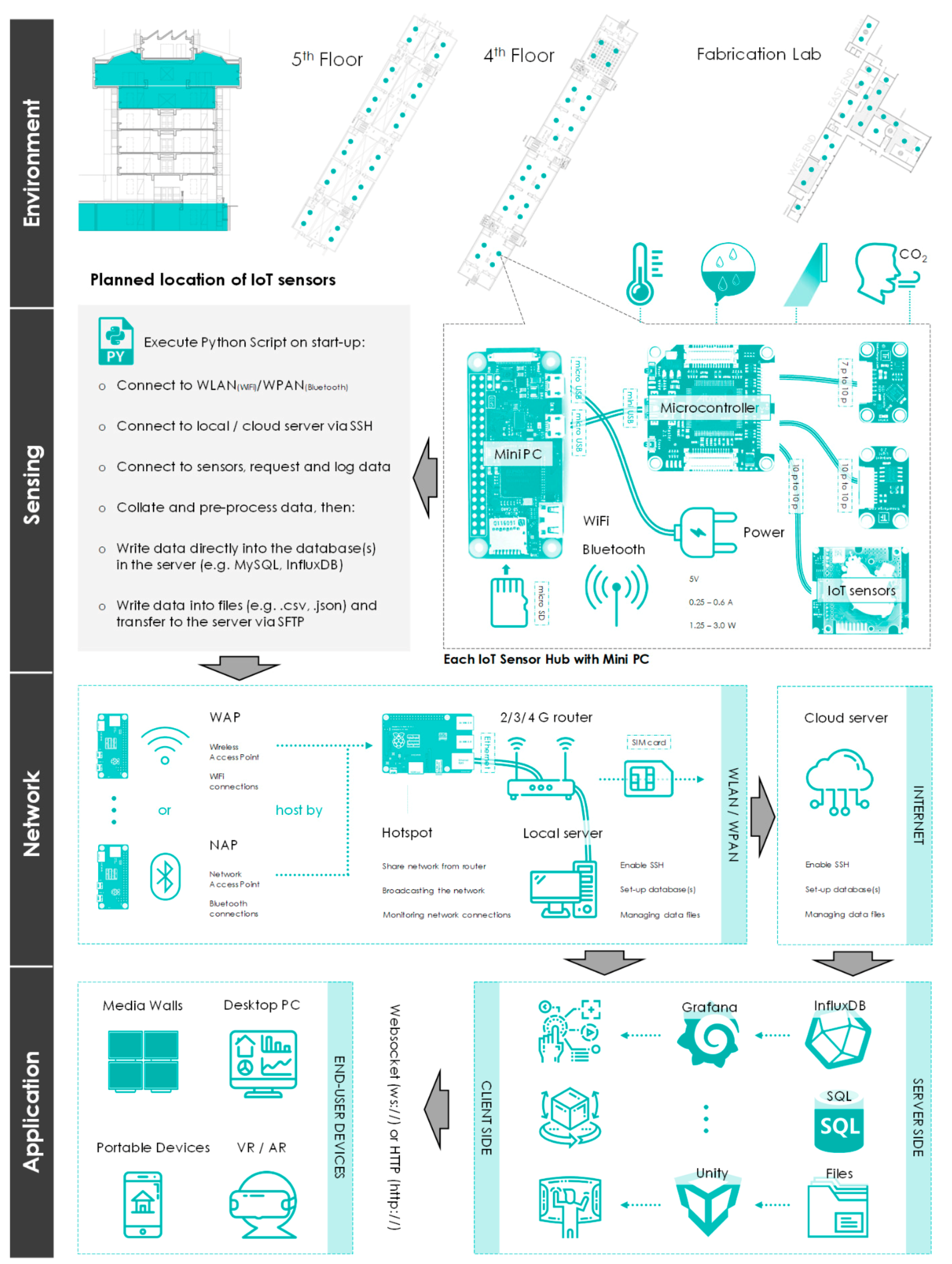
Appendix C
| Subject ID | Personal Information | Time | Personal Factor | ||
|---|---|---|---|---|---|
| Gender | Age Group | CLO Value | Activity Level | ||
| (Male/Female) | 15–19 | 20–24 | 25–30 | 30–34 | 35–40 | above | (Between 0–3.5) | Seated | Standing Relaxed | Standing Working | Reclining | Walking | Running | Other | ||
| RS 01A | 10:20 | ||||
| 10:30 | |||||
| 10:40 | |||||
| 10:50 | |||||
| 11:00 | |||||
| 11:10 | |||||
| 11:20 | |||||
| 11:30 | |||||
| Subjective Vote | |||||||||||
|---|---|---|---|---|---|---|---|---|---|---|---|
| Thermal Sensation: How Are You Feeling at the Moment? | Preference: What Kind of Improvement You Prefer at the Moment? | ||||||||||
| Cold | Cool | Slightly Cool | Neutral | Slightly Warm | Warm | Hot | Much Warmer | Slightly Warmer | No Change | Slightly Cooler | Much Cooler |
| −3 | −2 | −1 | 0 | 1 | 2 | 3 | −2 | −1 | 0 | 1 | 2 |
| Remarks | ||||
|---|---|---|---|---|
| Do You Think the Workshop Gave You Better Understanding about Invisible Thermal Data and the Environment? | ||||
| Strongly disagree | Disagree | Neutral | Agree | Strongly agree |
| −2 | −1 | 0 | 1 | 2 |
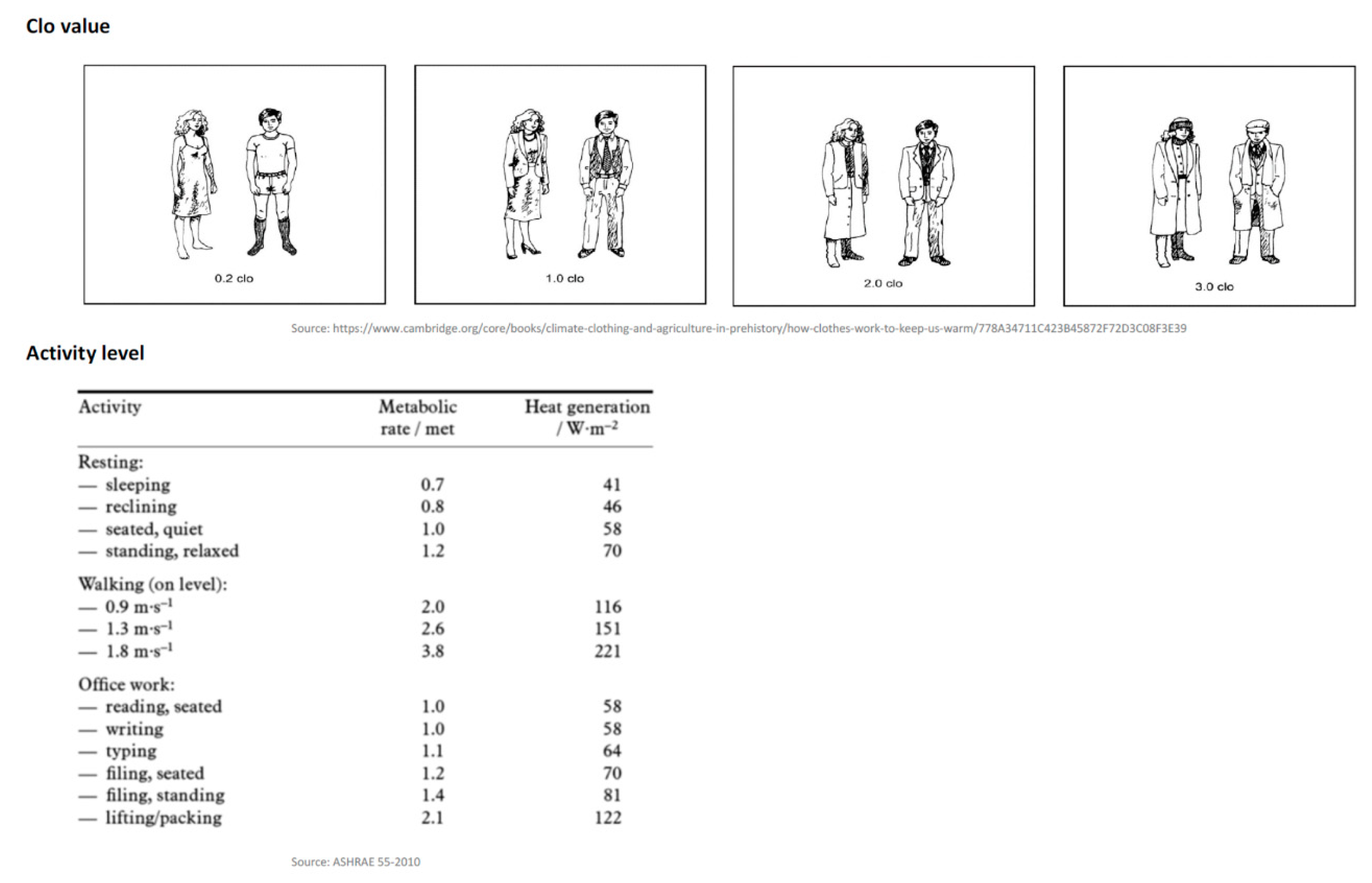
Appendix D

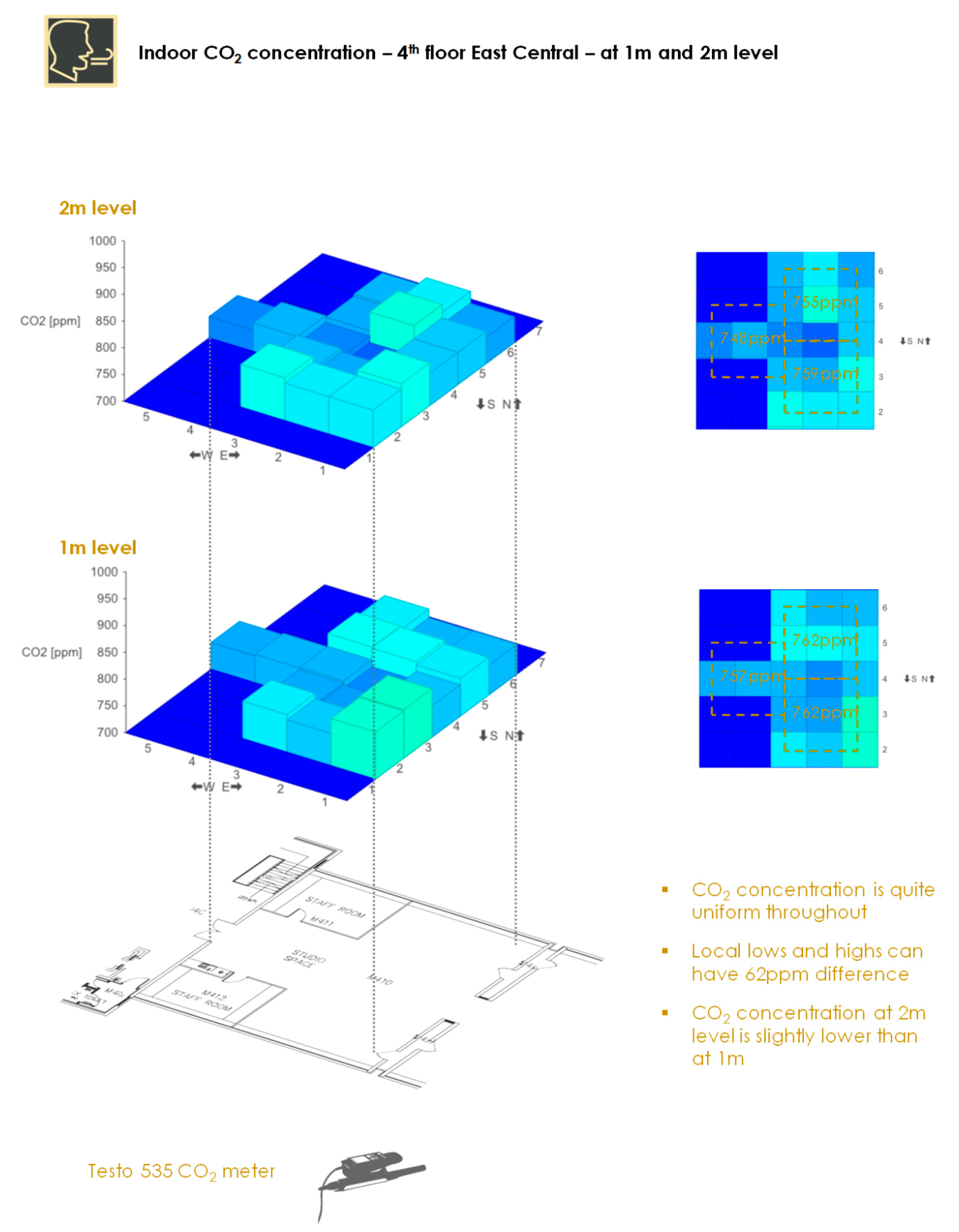

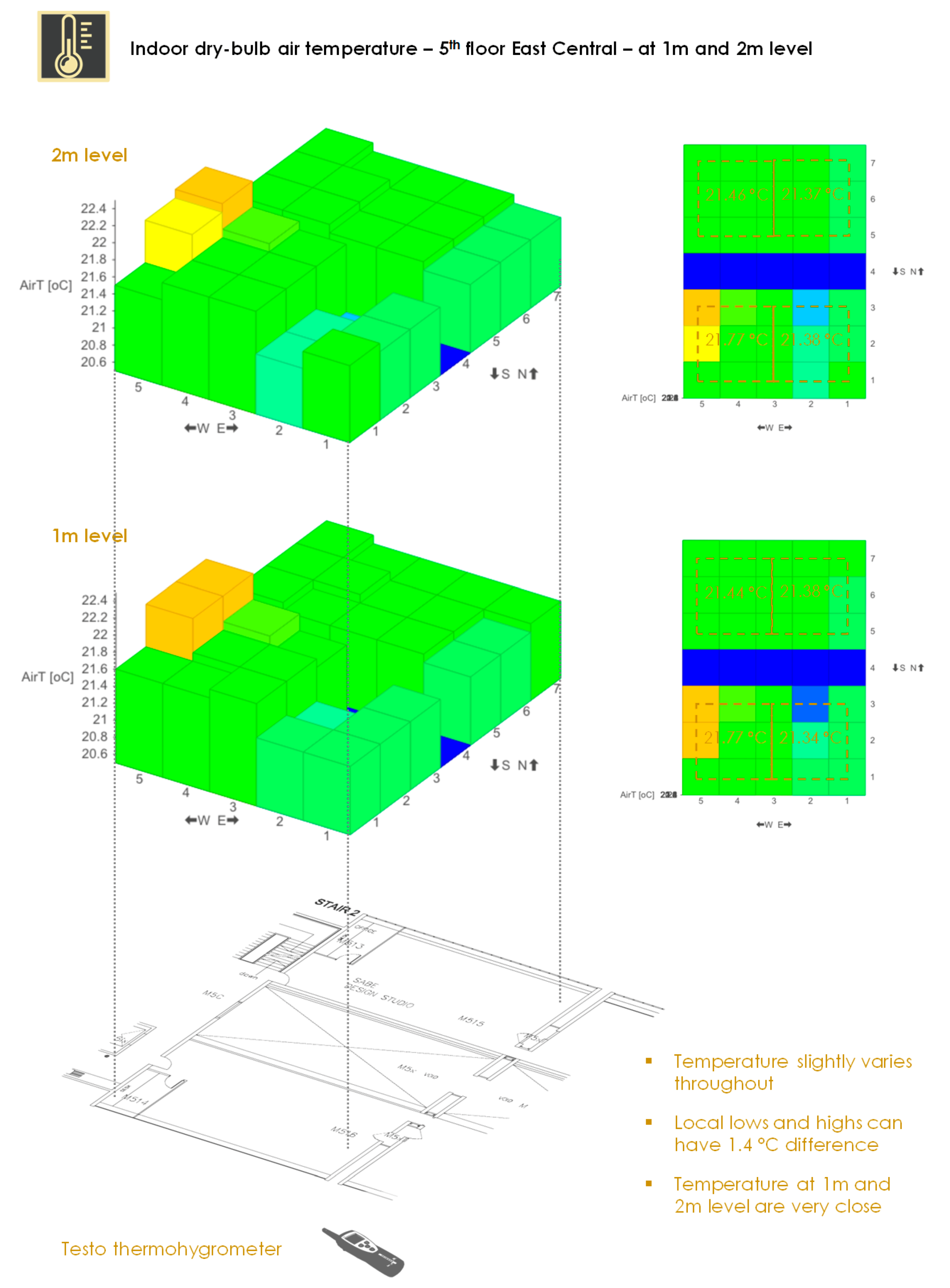
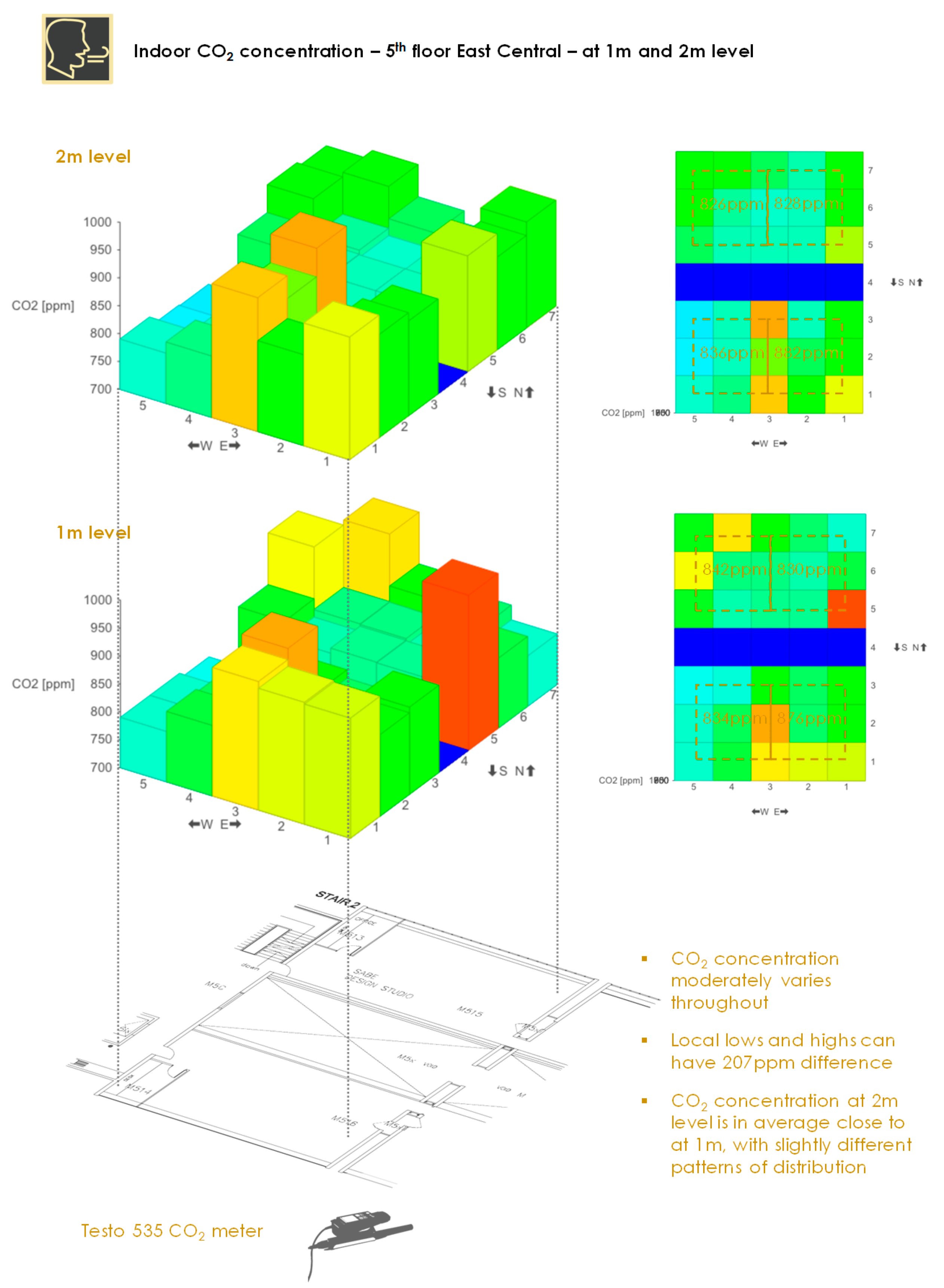

References
- Gaur, A.; Scotney, B.; Parr, G.; McClean, S. Smart City Architecture and its Applications Based on IoT. Procedia Comput. Sci. 2015, 52, 1089–1094. [Google Scholar] [CrossRef]
- Sethi, P.; Sarangi, S.R. Internet of Things: Architectures, Protocols, and Applications. J. Electr. Comput. Eng. 2017, 2017, 1–25. [Google Scholar] [CrossRef]
- Li, S.; Da Xu, L.; Zhao, S. The internet of things: A survey. Inf. Syst. Front. 2014, 17, 243–259. [Google Scholar] [CrossRef]
- Ahmad, M.W.; Mourshed, M.; Mundow, D.; Sisinni, M.; Rezgui, Y. Building energy metering and environmental monitoring—A state-of-the-art review and directions for future research. Energy Build. 2016, 120, 85–102. [Google Scholar] [CrossRef]
- Bui, N.; Castellani, A.P.; Casari, P.; Zorzi, M. The internet of energy: A web-enabled smart grid system. IEEE Netw. 2012, 26, 39–45. [Google Scholar] [CrossRef]
- Shah, J.; Mishra, B. IoT enabled environmental monitoring system for smart cities. In Proceedings of the 2016 International Conference on Internet of Things and Applications (IOTA), Institute of Electrical and Electronics Engineers (IEEE). Pune, India, 22–24 January 2016; pp. 383–388. [Google Scholar]
- Iera, A.; Floerkemeier, C.; Mitsugi, J.; Morabito, G. The Internet of things. IEEE Wirel. Commun. 2010, 17, 8–9. [Google Scholar] [CrossRef]
- Minoli, D.; Sohraby, K.; Occhiogrosso, B. IoT Considerations, Requirements, and Architectures for Smart Buildings—Energy Optimization and Next-Generation Building Management Systems. IEEE Internet Things J. 2017, 4, 269–283. [Google Scholar] [CrossRef]
- Wei, C.; Li, Y. Design of energy consumption monitoring and energy-saving management system of intelligent building based on the Internet of things. In Proceedings of the 2011 International Conference on Electronics, Communications and Control (ICECC), Institute of Electrical and Electronics Engineers (IEEE). Ningbo, China, 9–11 September 2011; pp. 3650–3652. [Google Scholar]
- Lehrer, D.; Vasudev, J. Visualizing Energy Information in Commercial Buildings: A Study of Tools, Expert Users, and Building Occupants. UC Berkeley: Center for the Built Environment. 2011. Available online: https://escholarship.org/uc/item/6vp5m5m3 (accessed on 2 May 2020).
- Janssen, M.; Luthra, S.; Mangla, S.; Rana, N.P.; Dwivedi, Y.K. Challenges for adopting and implementing IoT in smart cities. Internet Res. 2019, 29, 1589–1616. [Google Scholar] [CrossRef]
- Xu, B.; Li, L.; Hu, D.; Wu, B.; Ye, C.; Cai, H. Healthcare data analysis system for regional medical union in smart city. J. Manag. Anal. 2018, 5, 1–16. [Google Scholar] [CrossRef]
- Fernández-Ares, A.; Mora, A.; Arenas, M.G.; García-Sánchez, P.; Romero, G.; Rivas, V.; Castillo, P.; Guervós, J.J.M. Studying real traffic and mobility scenarios for a Smart City using a new monitoring and tracking system. Futur. Gener. Comput. Syst. 2017, 76, 163–179. [Google Scholar] [CrossRef]
- Li, S.; Xu, L.D. Securing the Internet of Things; Syngress Publishing: Rockland, MA, USA, 2017. [Google Scholar]
- Kelly, S.; Suryadevara, N.K.; Mukhopadhyay, S. Towards the Implementation of IoT for Environmental Condition Monitoring in Homes. IEEE Sensors J. 2013, 13, 3846–3853. [Google Scholar] [CrossRef]
- Stavropoulos, T.G.; Tsioliaridou, A.; Koutitas, G.; Vrakas, D.; Vlahavas, I. System Architecture for a Smart University Building. In Proceedings of the International Conference on Artificial Neural Networks, Thessaloniki, Greece, 15–18 September 2010; pp. 477–482. [Google Scholar]
- Jakubiec, J.A.; Doelling, M.C.; Heckmann, O.; Thambiraj, R.; Jathar, V. Dynamic Building Environment Dashboard: Spatial Simulation Data Visualization in Sustainable Design. Technol. Des. 2017, 1, 27–40. [Google Scholar] [CrossRef]
- Groat, L.N.; Wang, D. Architectural Research Methods; Wiley: Hoboken, NJ, USA, 2013. [Google Scholar]
- Guerra-Santin, O.; Tweed, C.A. In-use monitoring of buildings: An overview of data collection methods. Energy Build. 2015, 93, 189–207. [Google Scholar] [CrossRef]
- HEFCE. Guide to Post Occupancy Evaluation. The Higher Education Funding Council for England. The University of Westminster: UK. 2006. Available online: http://www.smg.ac.uk/documents/POEBrochureFinal06.pdf (accessed on 21 April 2020).
- Turpin-Brooks, S.; Viccars, G. The development of robust methods of post occupancy evaluation. Facilities 2006, 24, 177–196. [Google Scholar] [CrossRef]
- Field, A. Discovering Statistics Using IBM SPSS Statistics; Sage Publications: London, UK, 2013. [Google Scholar]
- Aghemo, C.; Virgone, J.; Fracastoro, G.; Pellegrino, A.; Blaso, L.; Savoyat, J.; Johannes, K. Management and monitoring of public buildings through ICT based systems: Control rules for energy saving with lighting and HVAC services. Front. Arch. Res. 2013, 2, 147–161. [Google Scholar] [CrossRef]
- Peretti, C.; Schiavon, S. Indoor Environmental Quality Surveys. A Brief Literature Review. UC Berkeley: Center for the Built Environment. 2011. Available online: https://escholarship.org/uc/item/0wb1v0ss (accessed on 2 May 2020).
- Bordass, W.; Leaman, A.; Eley, J.A. Guide to Feedback and Post-Occupancy Evaluation. The Usable Buildings Trust 2006 [online]. 2006. Available online: https://usablebuildings.co.uk/ (accessed on 25 January 2018).
- Leaman, A. PROBE 10: Occupancy Survey Analysis. Build. Serv. J. 1997, 5, 37–41. [Google Scholar]
- Ford, B.; Schiano-Phan, R.; Vallejo, J.A. The Architecture of Natural Cooling; Routledge: Abingdon, UK, 2019. [Google Scholar]
- Gossauer, E.; Wagner, A. Post-occupancy Evaluation and Thermal Comfort: State of the Art and New Approaches. Adv. Build. Energy Res. 2007, 1, 151–175. [Google Scholar] [CrossRef]
- Humphreys, M.A.; Nicol, J.F.; Raja, I.A. Field Studies of Indoor Thermal Comfort and the Progress of the Adaptive Approach. Adv. Build. Energy Res. 2007, 1, 55–88. [Google Scholar] [CrossRef]
- Hossain, M.; Wilson, R.; Lau, B.; Ford, B. Thermal comfort guidelines for production spaces within multi-storey garment factories located in Bangladesh. Build. Environ. 2019, 157, 319–345. [Google Scholar] [CrossRef]
- Hossain, M.; Lau, B.; Wilson, R.; Ford, B. Effect of changing window type and ventilation strategy on indoor thermal environment of existing garment factories in Bangladesh. Arch. Sci. Rev. 2017, 60, 299–315. [Google Scholar] [CrossRef]
- Schiano-Phan, R. Post-occupancy evaluation of non-domestic buildings using Passive Downdraught Evaporative Cooling (PDEC) in south-west USA. Archit. Sci. Rev. 2012, 55, 320–340. [Google Scholar] [CrossRef]
- Allal, B.; Mongazon-Cazavet, K.; Al Agha, S.S.; Gourhant, Y. A green small cells deployment in 5G—Switch ON/OFF via IoT networks & energy efficient mesh backhauling. In Proceedings of the 2017 IFIP Networking Conference (IFIP Networking) and Workshops, Stockholm, Sweden, 12–15 June 2017; pp. 1–2. [Google Scholar]
- Tian, Y.; Li, T.; Song, W.; Fong, S.; Song, L.; Han, J. Chapter 18: Smart Power Management Internet of Things System with 5G and LoRa Hybrid Wireless Network. In 5G-Enabled Internet of Things; Wu, Y., Huang, H., Wang, C., Pan, Y., Eds.; CRC Press, Taylor and Francis: Boca Raton, FL, USA, 2019. [Google Scholar]
- Trend Control Systems Ltd. IQ®VISION Building Management Supervisor. IQVISION Brochure. 2018. Available online: https://www.trendcontrols.com/en-GB/latestproducts/Documents/IQVISION_Brochure_LR.pdf (accessed on 2 May 2020).
- Instrumart. Testo 535 Ambient CO2 Monitor—Instruction Manual. 2020. Available online: https://www.instrumart.com/assets/testo-535-manual.pdf (accessed on 28 March 2020).
- Trend Control Systems Limited. Data Sheet of TREND CO2, Temperature, Humidity Sensors. 2015. Available online: https://partners.trendcontrols.com/trendproducts/cd/de/pdf/en-ta201169-uk0yr0815g.pdf (accessed on 28 March 2020).
- Tinker Forge. Master Brick. 2020. Available online: https://www.tinkerforge.com/en/doc/Hardware/Bricks/Master_Brick.html (accessed on 2 May 2020).
- Blue Maestro Favicon. Tempo Disc™ Bluetooth Temperature, Humidity and Dew Point Sensor Beacon and Data Logger. 2020. Available online: https://bluemaestro.com/products/tempo-disc-bluetooth-temperature-humidity-sensor-beacon-logger (accessed on 3 April 2020).
- Freepik Company S.L. Flaticon Free Icons. 2018. Available online: https://www.flaticon.com (accessed on 3 December 2018).
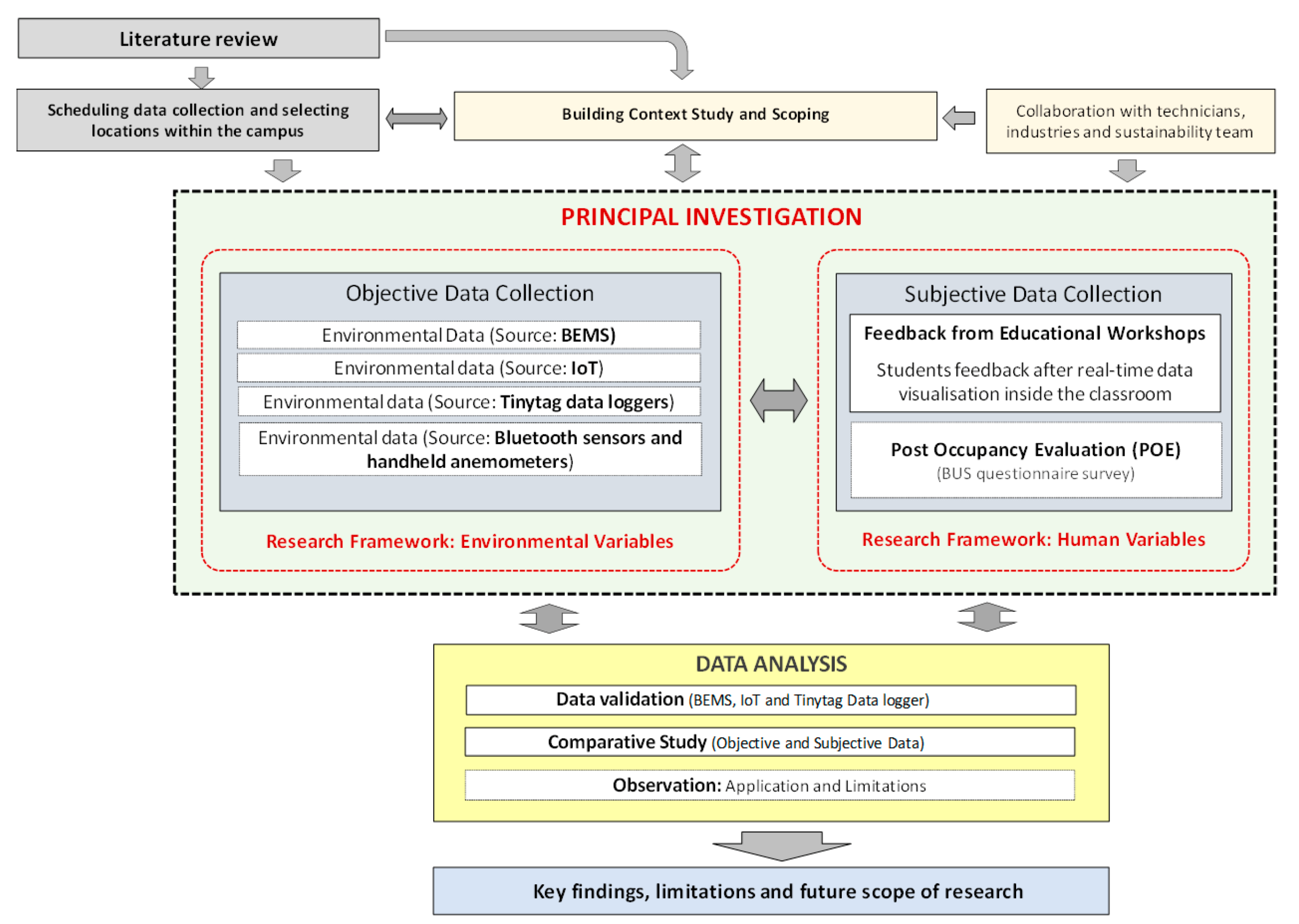
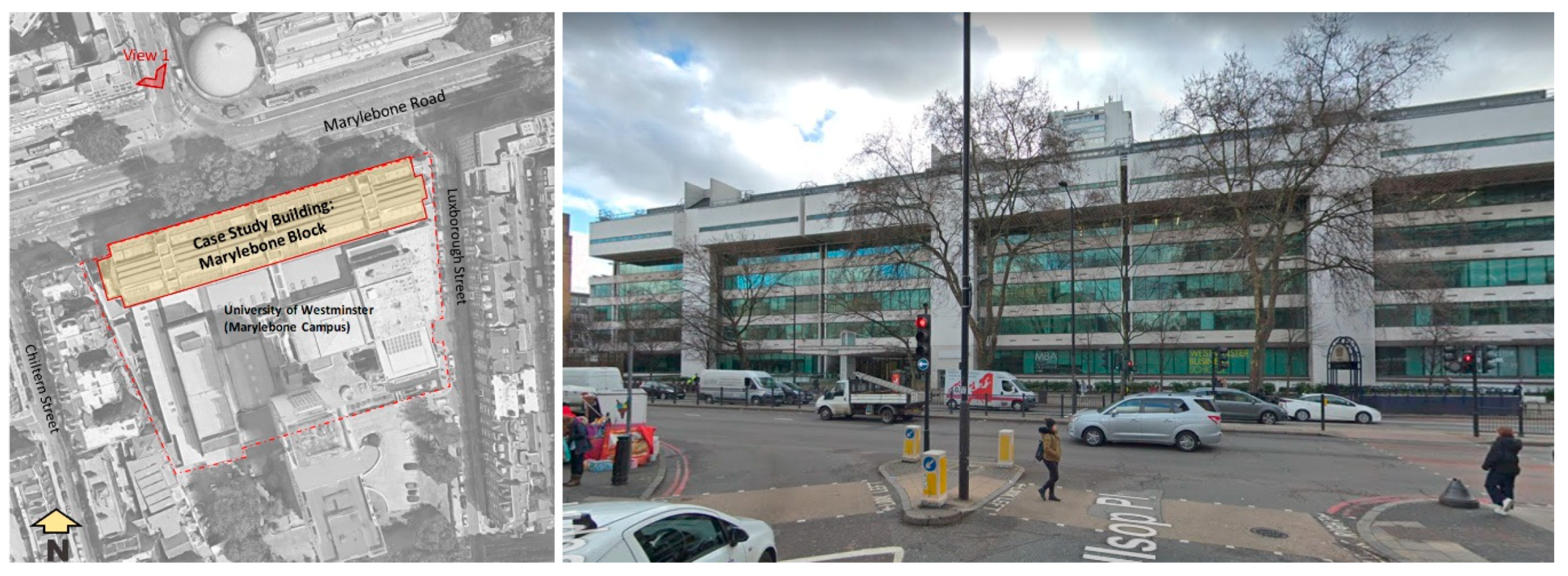


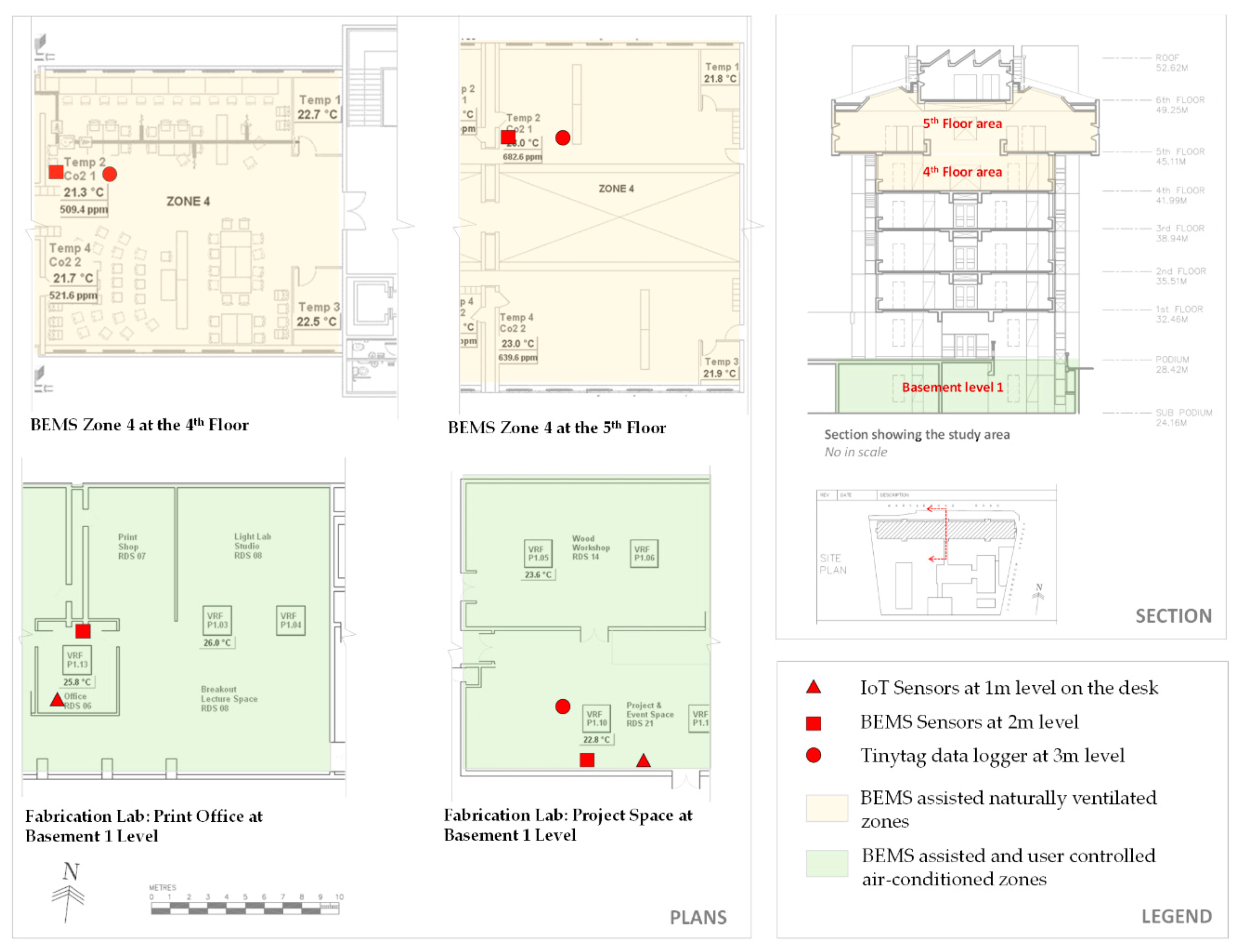
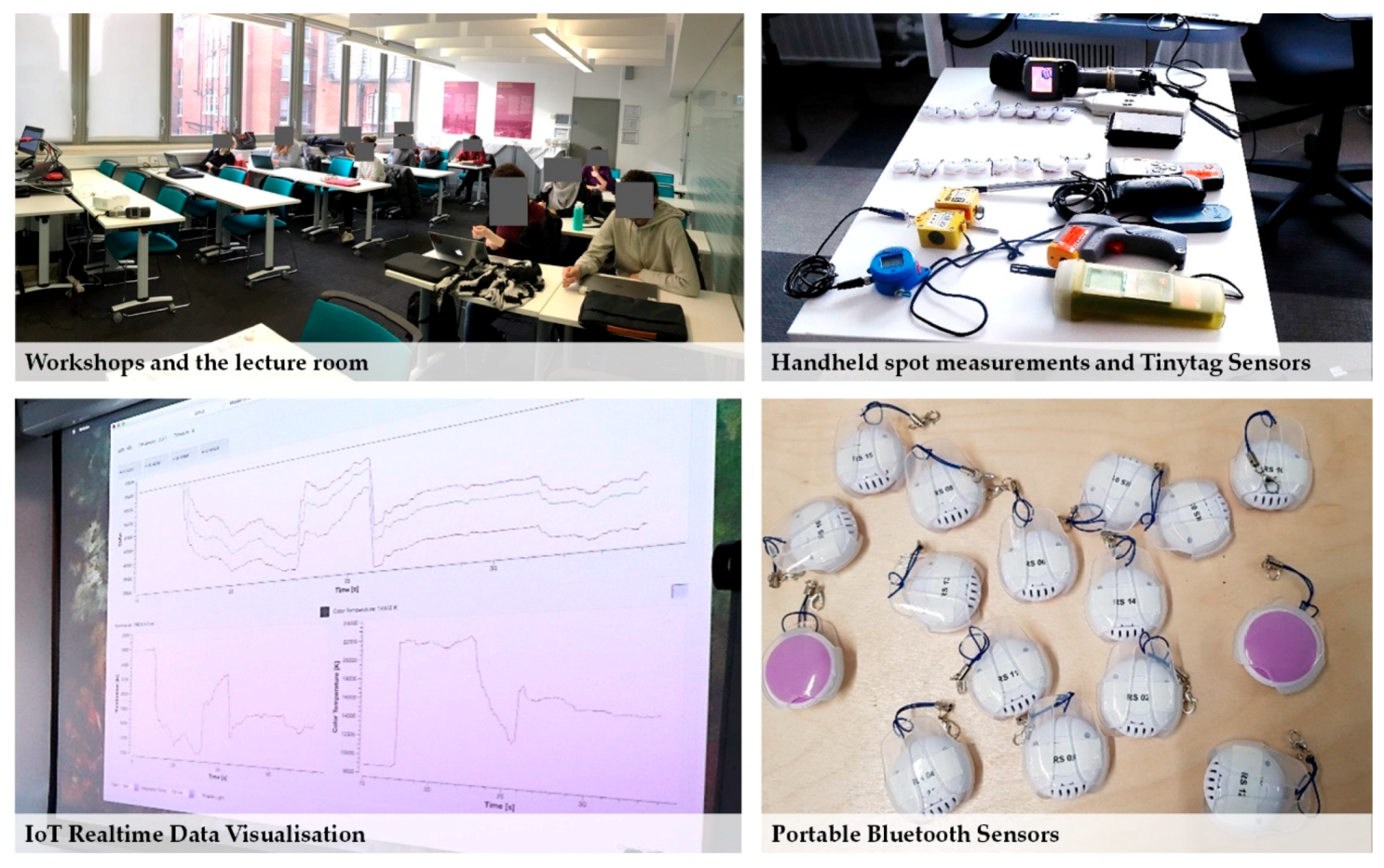
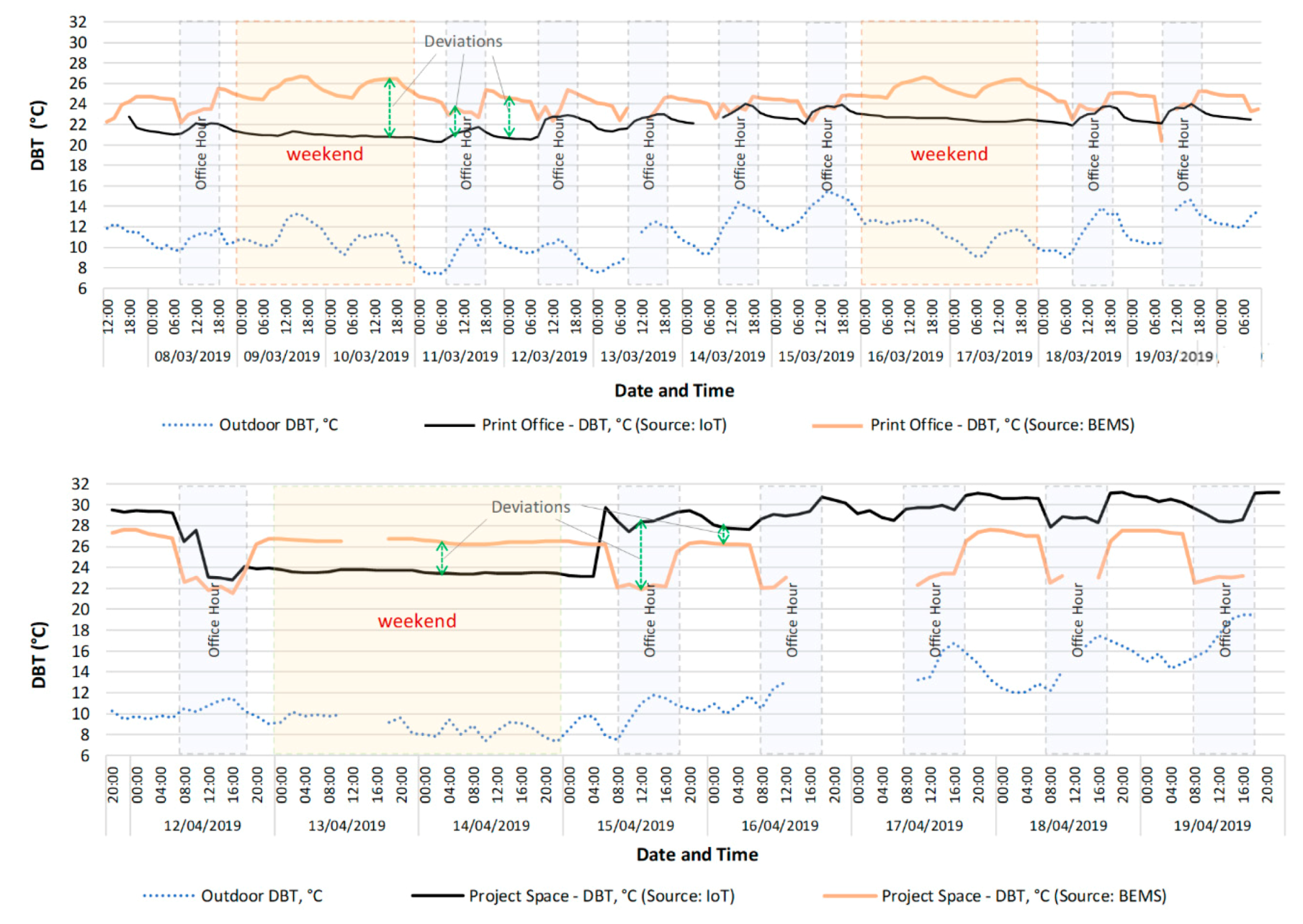
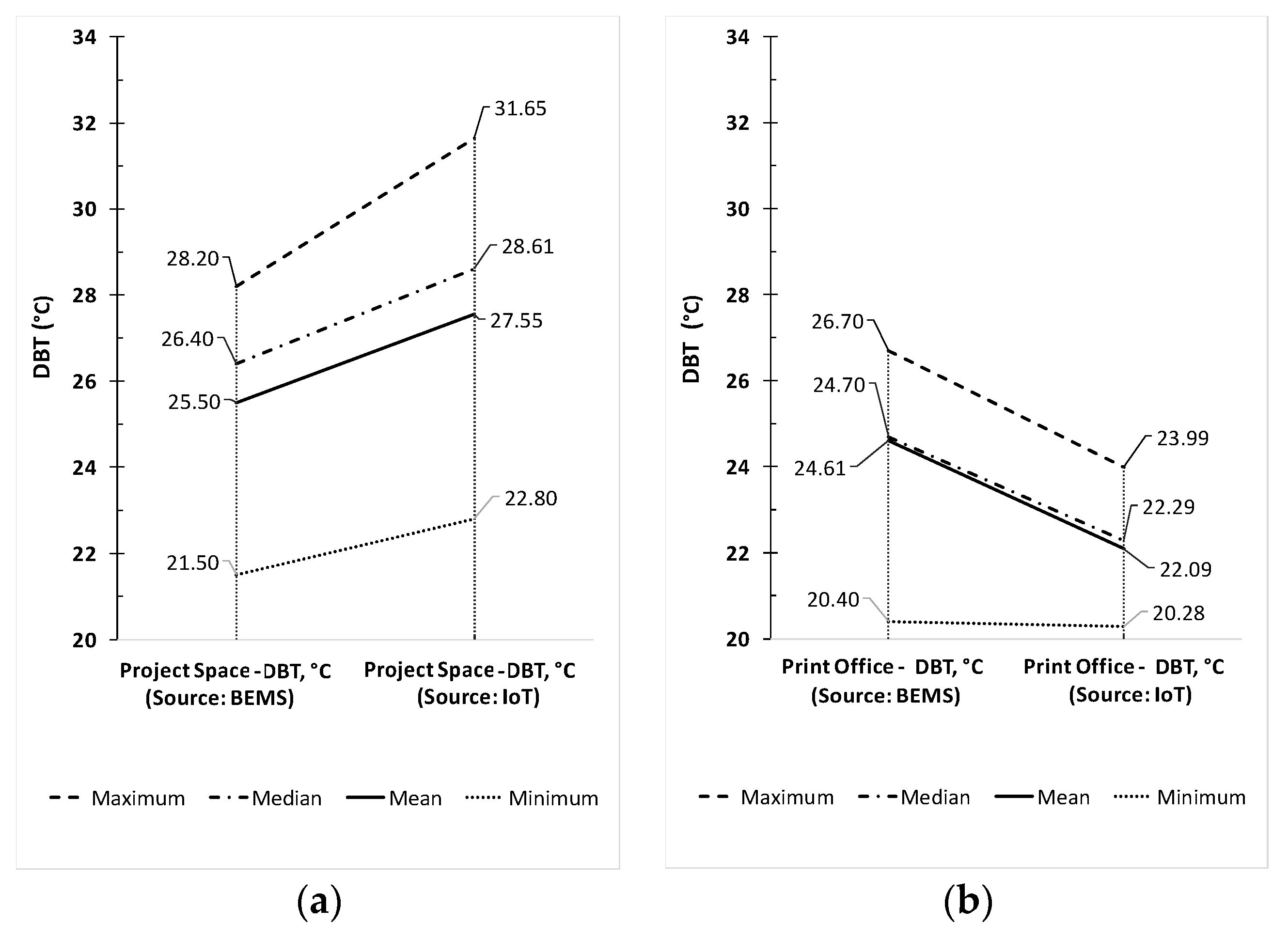
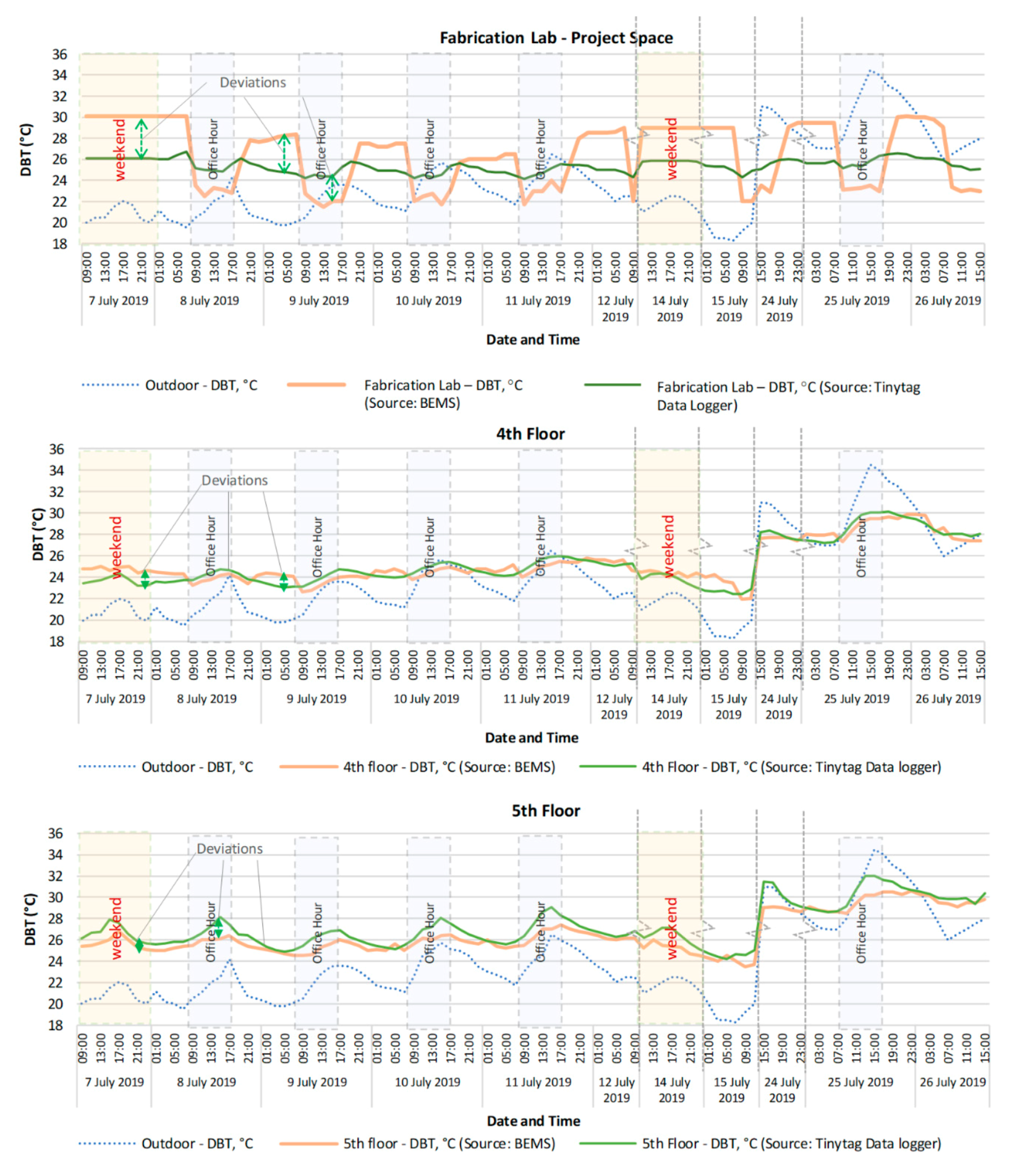

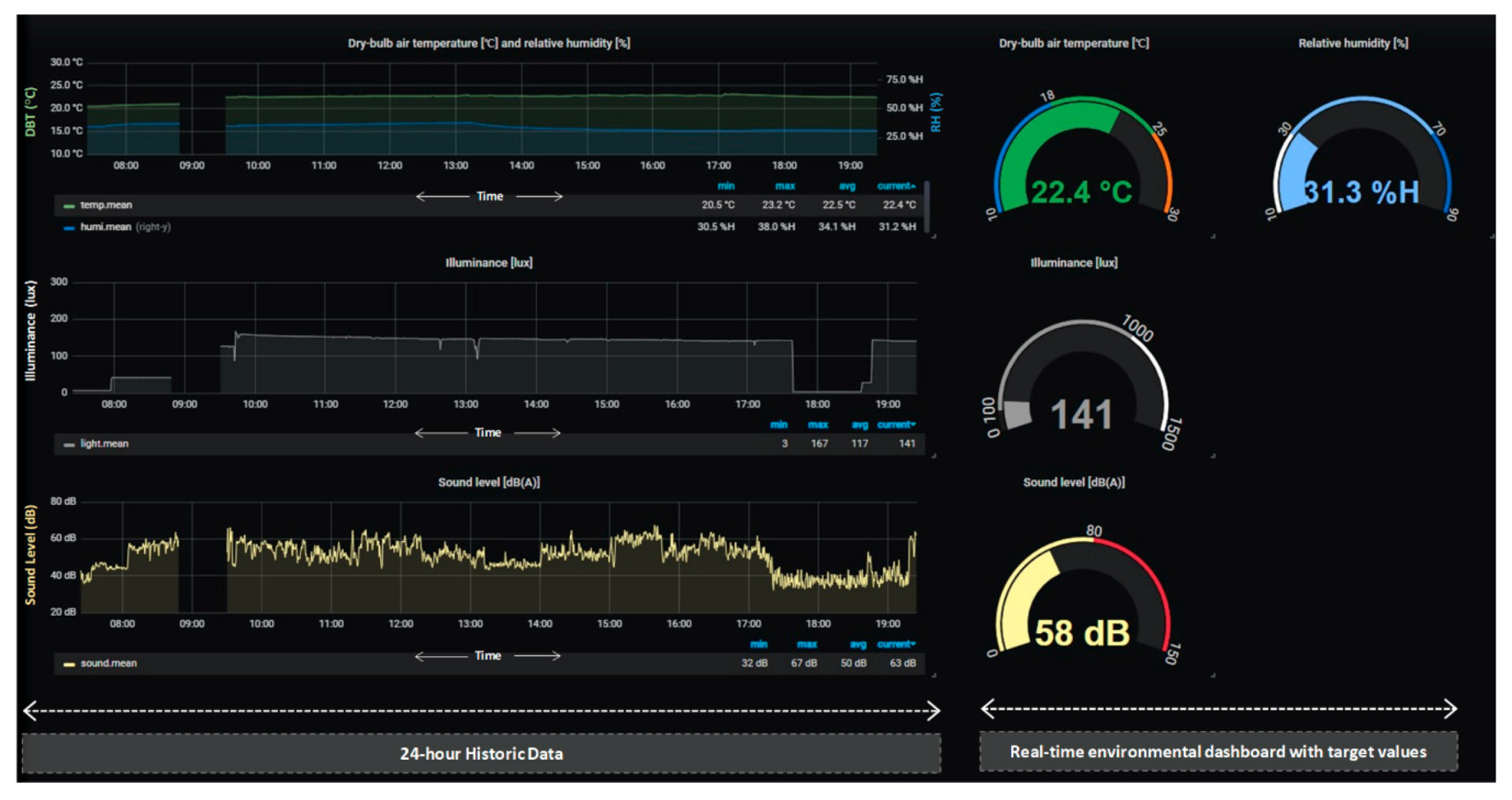


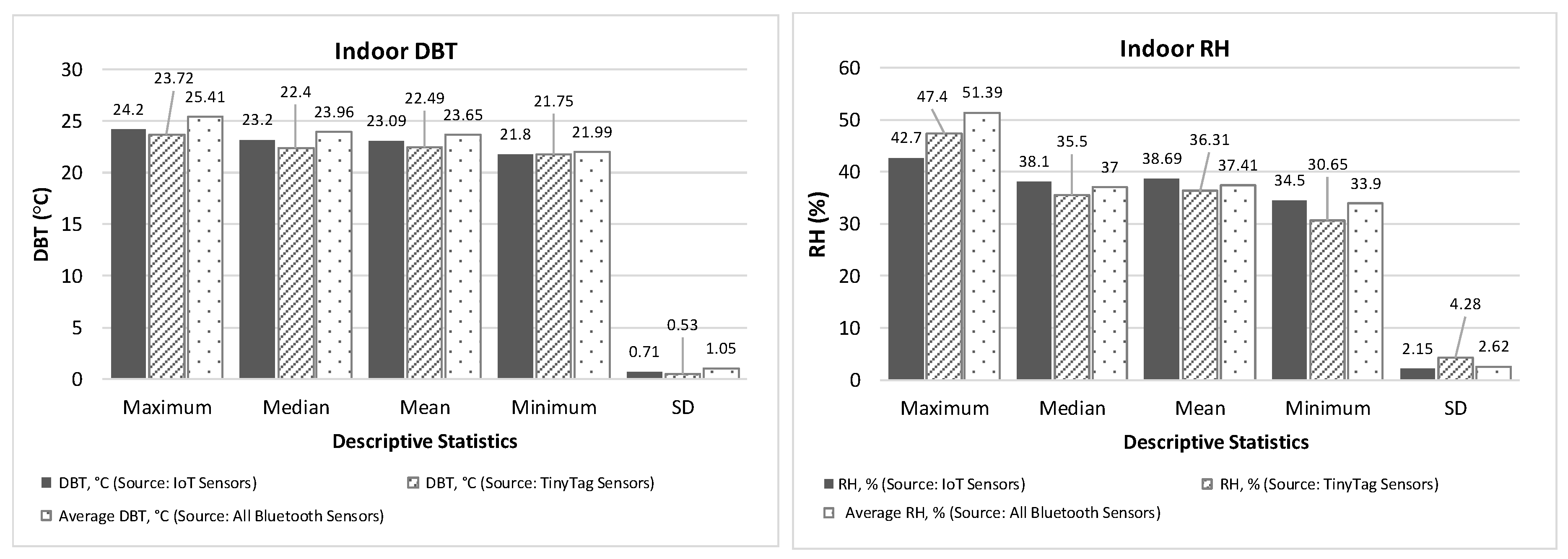
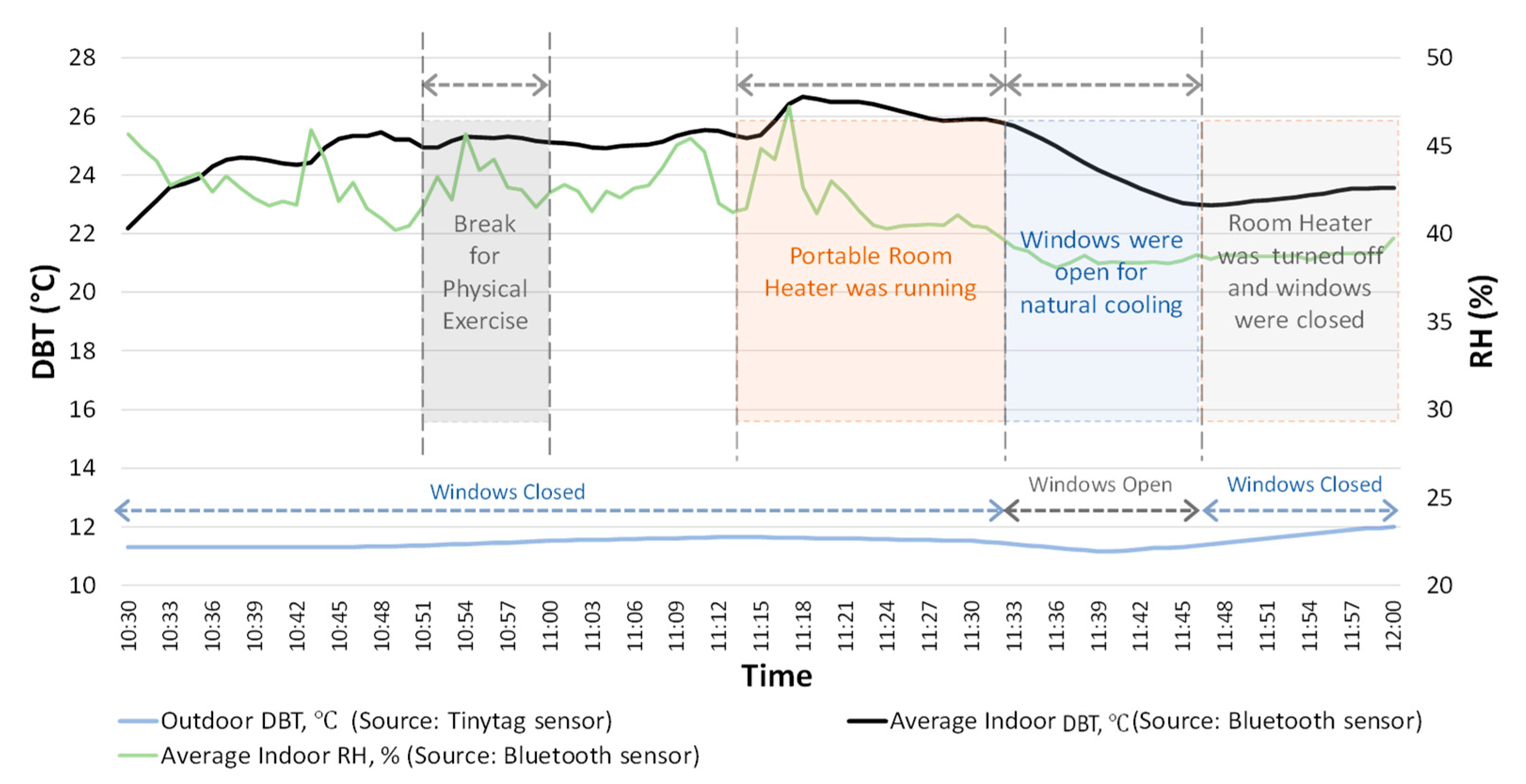
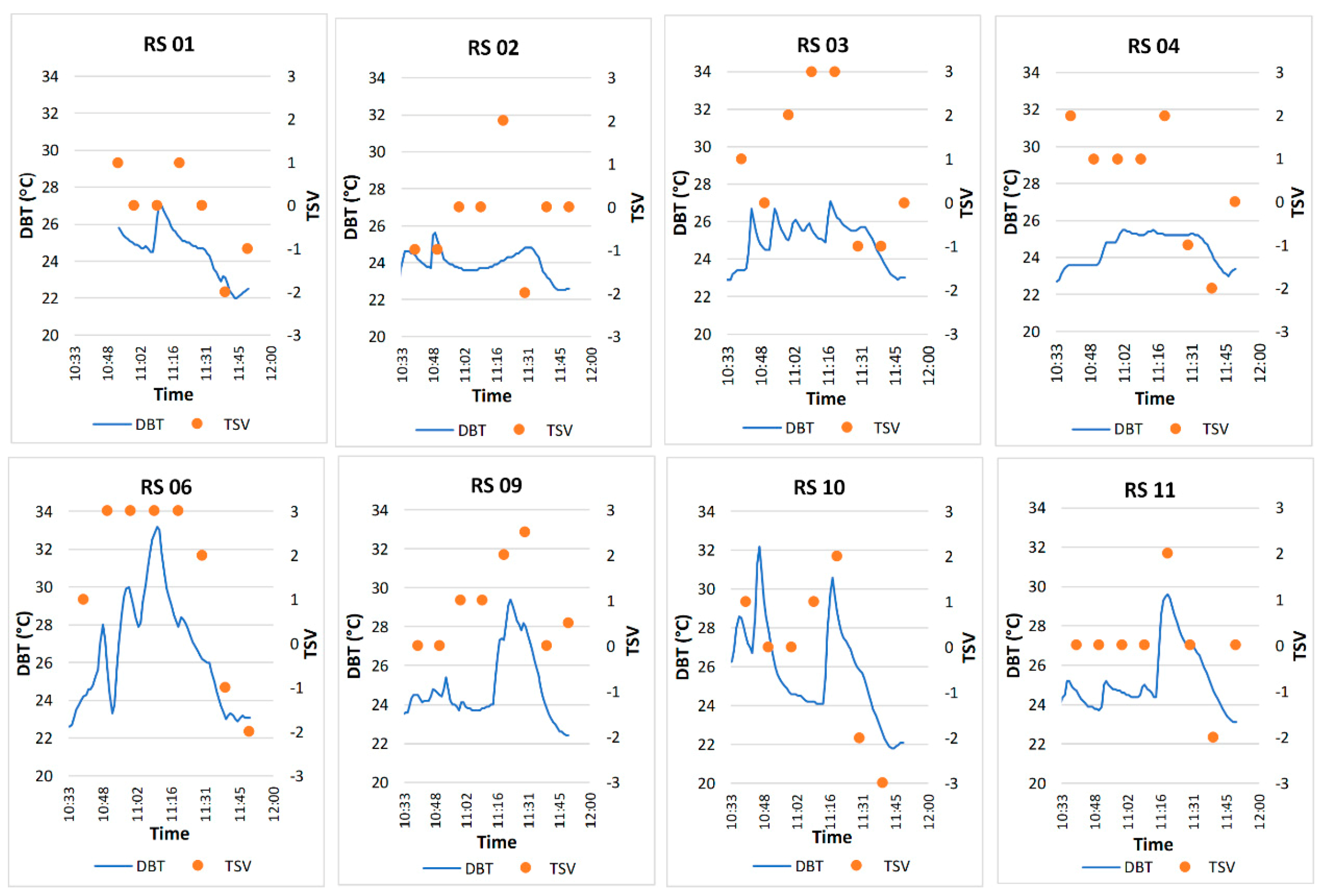
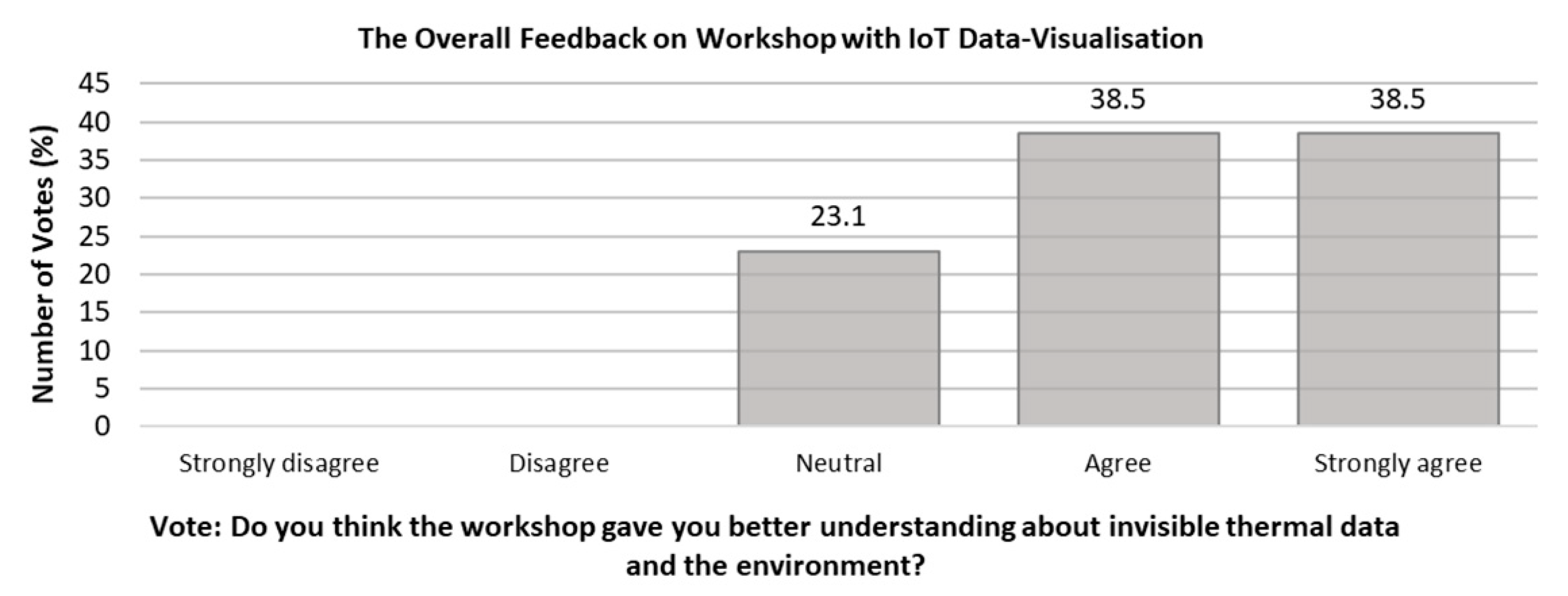
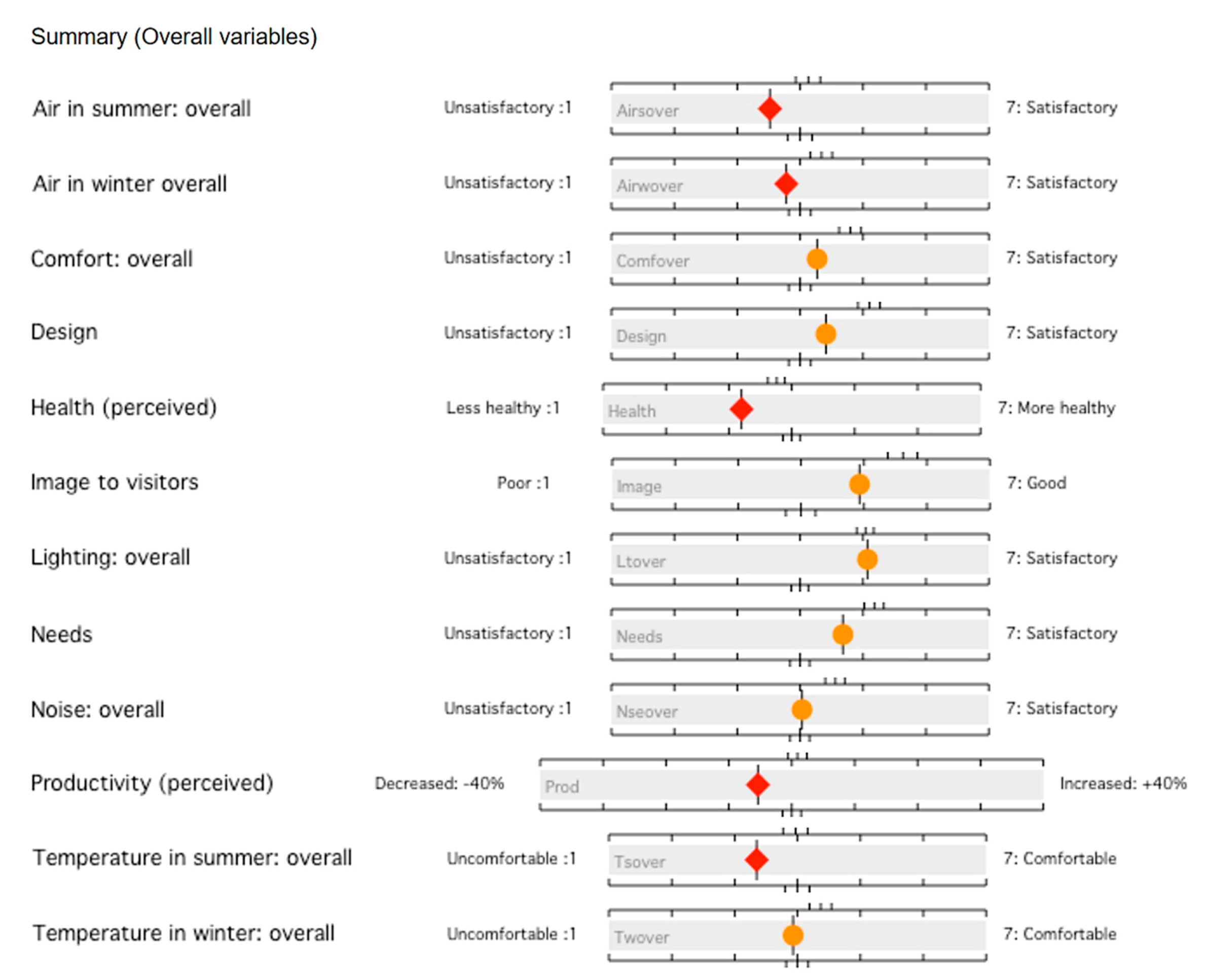
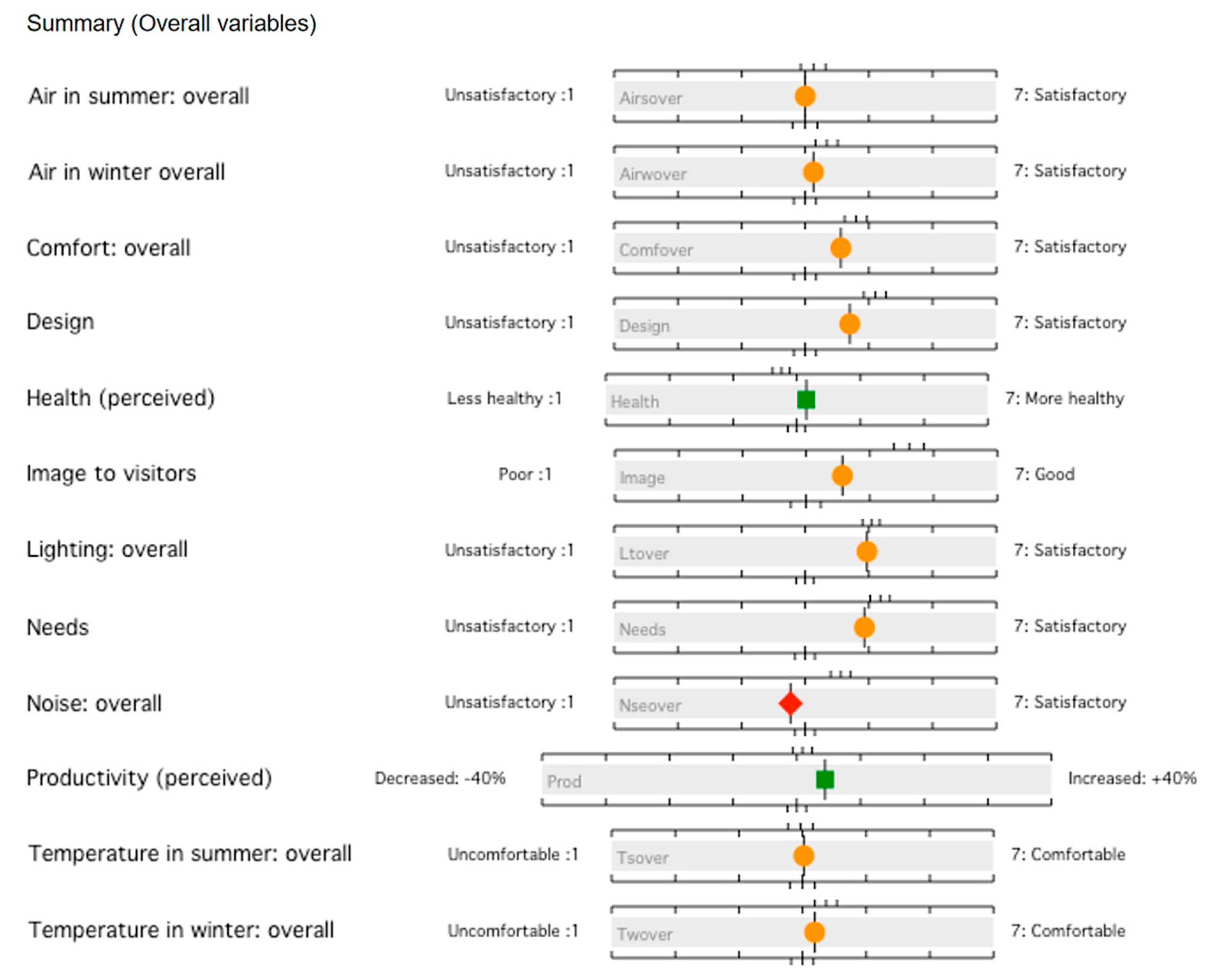
| Project Space—DBT, °C (Source: BEMS) | Project Space—DBT, °C (Source: IoT) | Print Office—DBT, °C (Source: BEMS) | Print Office—DBT, °C (Source: IoT) | |
|---|---|---|---|---|
| Maximum | 28.20 | 31.65 | 26.70 | 23.99 |
| Median | 26.40 | 28.61 | 24.70 | 22.29 |
| Mean | 25.50 | 27.55 | 24.61 | 22.09 |
| Minimum | 21.50 | 22.80 | 20.40 | 20.28 |
| SD | 2.04 | 3.08 | 1.10 | 0.94 |
| Data Count | 90 | 90 | 146 | 146 |
| Fabrication Lab’s Project Space—DBT, °C (Source: BEMS) | Fabrication Lab’s Project Space—DBT, °C (Source: Tinytag Sensors) | 4th Floor—DBT, °C (Source: BEMS) | 4th Floor—DBT, °C (Source: Tinytag Sensors) | 5th Floor—DBT, °C (Source: BEMS) | 5th Floor—DBT, °C (Source: Tinytag Sensors) | |
|---|---|---|---|---|---|---|
| Maximum | 30.10 | 26.70 | 29.90 | 30.13 | 30.60 | 32.03 |
| Median | 27.50 | 25.37 | 24.60 | 24.52 | 26.00 | 26.64 |
| Mean | 26.51 | 25.38 | 25.37 | 25.27 | 26.54 | 27.29 |
| Minimum | 21.50 | 24.15 | 21.90 | 22.42 | 23.50 | 24.22 |
| SD | 3.01 | 0.63 | 0.19 | 0.21 | 1.88 | 1.99 |
| Data Count | 99 | 99 | 99 | 99 | 99 | 99 |
| Advantages | Limitations | |
| Existing BEMS Sensor |
|
|
| IoT Sensors |
|
|
© 2020 by the authors. Licensee MDPI, Basel, Switzerland. This article is an open access article distributed under the terms and conditions of the Creative Commons Attribution (CC BY) license (http://creativecommons.org/licenses/by/4.0/).
Share and Cite
Hossain, M.; Weng, Z.; Schiano-Phan, R.; Scott, D.; Lau, B. Application of IoT and BEMS to Visualise the Environmental Performance of an Educational Building. Energies 2020, 13, 4009. https://doi.org/10.3390/en13154009
Hossain M, Weng Z, Schiano-Phan R, Scott D, Lau B. Application of IoT and BEMS to Visualise the Environmental Performance of an Educational Building. Energies. 2020; 13(15):4009. https://doi.org/10.3390/en13154009
Chicago/Turabian StyleHossain, Mohataz, Zhenzhou Weng, Rosa Schiano-Phan, David Scott, and Benson Lau. 2020. "Application of IoT and BEMS to Visualise the Environmental Performance of an Educational Building" Energies 13, no. 15: 4009. https://doi.org/10.3390/en13154009
APA StyleHossain, M., Weng, Z., Schiano-Phan, R., Scott, D., & Lau, B. (2020). Application of IoT and BEMS to Visualise the Environmental Performance of an Educational Building. Energies, 13(15), 4009. https://doi.org/10.3390/en13154009






